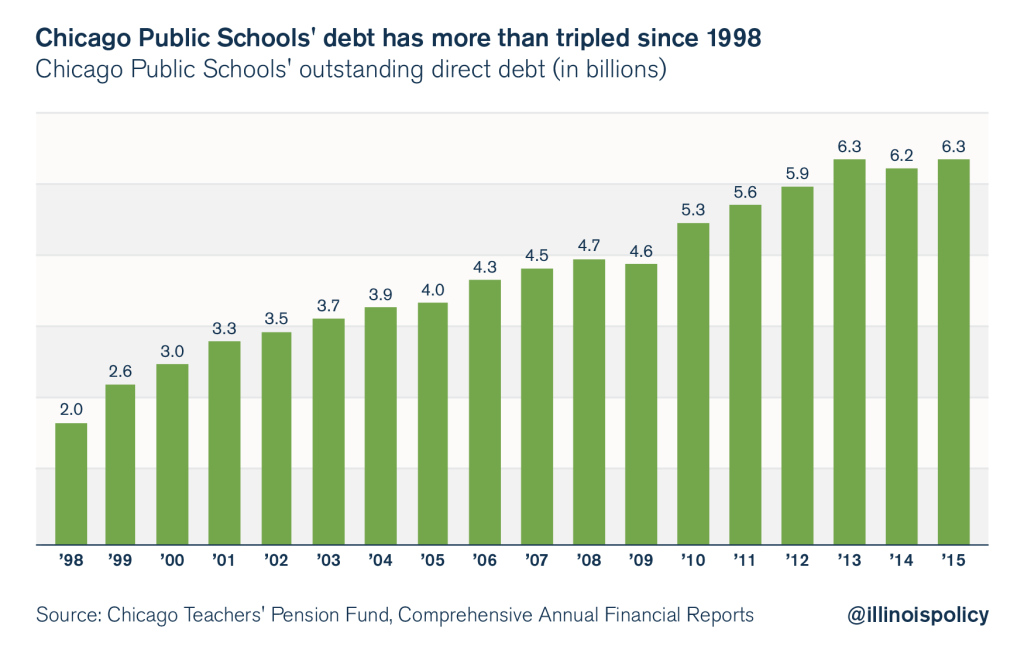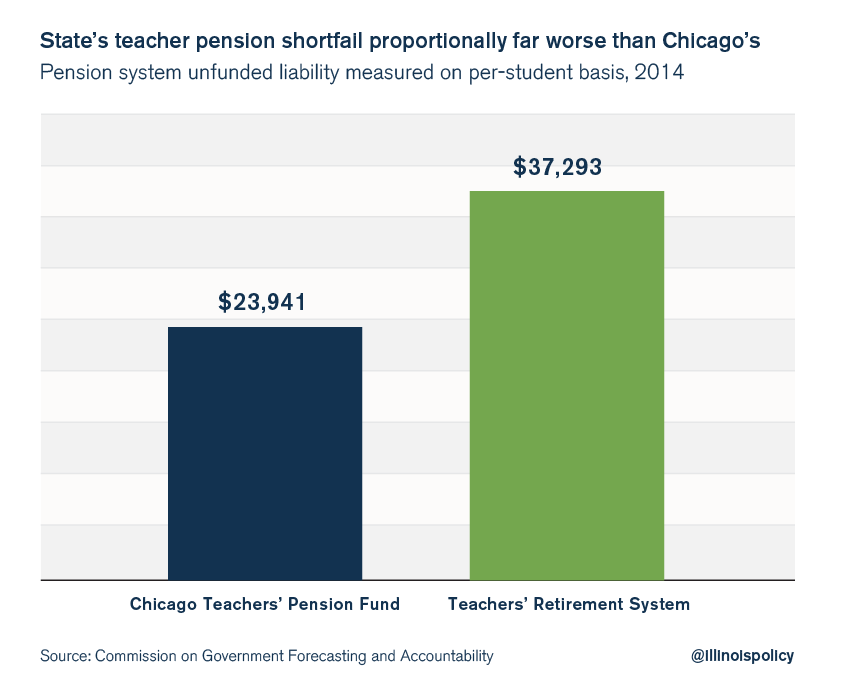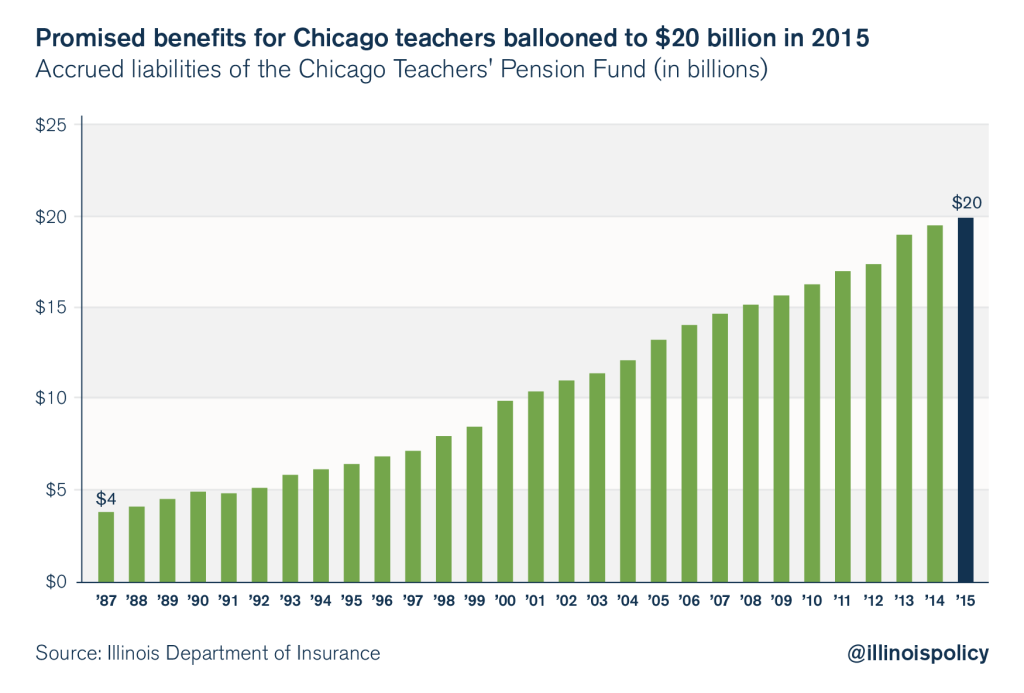Moody’s issues another CPS credit downgrade
Another credit downgrade shows borrowing, taxes and bailouts can’t fix CPS’ financial crisis, but real structural reforms are needed.
Moody’s Investor’s Service downgraded Chicago Public Schools’, or CPS’, debt further into junk-rating territory Sept. 26. CPS’ rating fell to B3 from B2 and was assigned a negative outlook by Moody’s, meaning the ratings firm could downgrade the school system again in the near future.
This latest downgrade is the clearest sign yet that CPS’ solution of borrowing, higher taxes and state bailouts can’t solve the school system’s financial crisis.
Moody’s said as much in its statement explaining the reasons for its downgrade. The ratings firm listed several reasons for the downgrade, including irresponsible borrowing, relying on state bailouts and growing pension costs that led CPS into its current situation.
- CPS, though mired in debt, continues to borrow money
Moody’s criticized CPS’ “cash flow borrowing” and “elevated debt service expenses” as a reason for its downgrade.
CPS has borrowed irresponsibly for decades. Between 1998 and 2015, the district tripled its outstanding debt burden to over $6 billion.

The annual cost of that borrowing is enormous. Moody’s notes that the interest rates on some CPS debts are a sky-high 9 percent. As a result, nearly 10 percent of all CPS revenues are dedicated to paying the district’s yearly debt service.
- CPS’ budget relies on unrealistic state bailouts
Moody’s also criticized CPS’ reliance on state bailouts to fix its budget, saying: “The downgrade is also based on CPS’s deepening structural deficit, with budgets that are built on unrealistic expectations of assistance from the state.”
The ratings firm is right to be skeptical. The state’s recent stopgap budget promised $100 million in extra education funds and potentially hundreds of millions in state pension contributions – yet CPS is demanding even more cash.
But the state can’t afford the bail out it’s already promised to CPS. It has profound financial difficulties of its own, such as an education pension crisis arguably worse than Chicago’s.
The Illinois Teachers’ Retirement System, or TRS, has a pension shortfall of nearly $62 billion. That dwarfs the pension shortfall for CPS, which is $9.5 billion.
In fact, when measured on a per-student basis – a better, apples-to-apples comparison – the state’s shortfall is 56 percent higher than Chicago’s. TRS has a short-fall of $37,000 per student, while Chicago’s shortfall totals $24,000.

In all, the state’s pension crisis now consumes 25 percent of Illinois’ general fund budget. That’s crowded out state spending on social services, higher education and nearly every other core government service.
With the state embroiled in its own financial crisis, any additional bail outs for CPS are unlikely to occur.
- CPS’ pension crisis is growing
Moody’s also cited CPS’ “escalating pension contribution requirements” as a reason for its downgrade.
CPS’ required contributions to the Chicago Teachers’ Pension Fund has skyrocketed in recent years, growing to over $700 million in 2017.
Those growing pension contributions are crippling CPS, forcing the school system to borrow money to make its payments and fund daily operations.
Despite this unsustainable status quo, CPS officials seem content to pour more and more taxpayer dollars into teacher pensions.
District officials won’t acknowledge that the pension debt, now at nearly $10 billion, is insurmountable without reforms. Nor will CPS admit the pension fund is in crisis due to district officials and city politicians treating the system as a slush fund for decades – overpromising benefits to buy support from teachers and skipping payments to fund other projects.
Total owed benefits to teachers have grown 6 percent annually over the past three decades, to $20 billion in 2015 from $4 billion in 1987, far faster than CPS’ revenues or Chicagoans’ incomes. That growth rate is simply unaffordable for CPS or city taxpayers.

- The Chicago Teachers Union opposes reforms
Moody’s didn’t just chastise CPS for its irresponsible habits. The ratings firm also called out the Chicago Teacher’s Union, or CTU, by saying that CPS’ downgrade was a result of “strong employee bargaining groups that impede cost cutting efforts.”
For example, CTU opposes ending the district’s practice of paying for, or “picking up,” a majority of Chicago teachers’ employee pension contributions.
Since 1981, CPS has paid the vast majority of what
teachers are supposed to contribute toward their own pensions. Over the last decade, the district spent more than $1.2 billion on these pension pickups. Had teachers made their own pension contributions, CPS could have spent that amount on the district’s pension contributions instead.

CPS officials now want to end pension pickups and have incorporated a phase-out of the benefit in the districts’ 2017 budget.
In response, the union has threatened to go on strike, ignoring the damage its last strike inflicted on the district, students and teachers themselves.
Moody’s suggestion: real reforms
According to Moody’s, the only way CPS can fix its finances and earn a credit upgrade is through “revenue growth and/or expenditure reductions.”
However, more revenue through higher taxes is not an option.
Chicagoans are already struggling under the highest city tax burden in Illinois – more tax increases will only serve to drive more families and businesses out of the city.
Instead, CPS and city officials have to find ways to reduce expenditures and seriously reform the way the district operates.
Moving new teachers into 401(k)-style retirement plans, offering optional 401(k)-style plans to current workers and negotiating additional reforms with CTU is a vital first step in that process.
